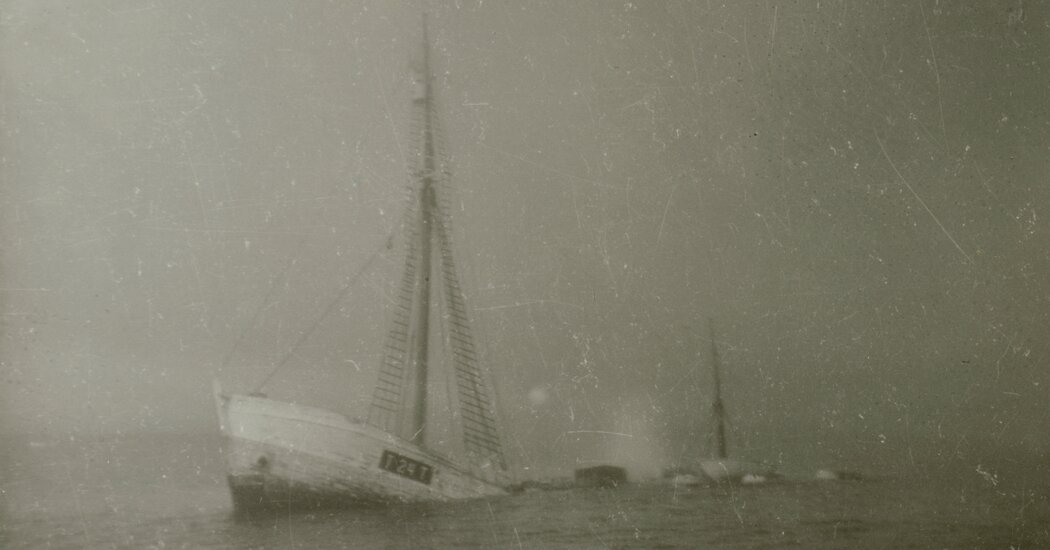Endurance, the ship that carried Ernest Shackleton on his ill-fated attempt to cross Antarctica in 1915, spawned one of the greatest survival stories in the history of exploration and now holds a revered place in polar history.
The discovery of its wreckage at the bottom of the Weddell Sea in 2022 put Shackleton back in the spotlight and rekindled interest in finding a lesser-known vessel, the Quest, which was carrying him back to Antarctica when he had a heart attack and died in 1922. The Quest sailed on for another 40 years until it sank on a seal-hunting voyage off Canada’s Atlantic coast in 1962.
On June 9, John Geiger, the leader of an expedition to find the Quest, saw an unusual shape pop up on his boat’s sonar detection screen as his research vessel floated off the coast of Newfoundland and Labrador. He knew almost immediately that a final discovery in the life of one of history’s most revered explorers had been made.
“This is the last big Shackleton event,” Alexandra Shackleton, the explorer’s granddaughter, said in an interview, referring to the discovery of the Quest. “There won’t be anything else as important as this.”
The expedition to find the Quest was led by the Royal Canadian Geographical Society, an educational charity of which Mr. Geiger is the chief executive, and cost 500,000 Canadian dollars, or about $365,000, according to a spokeswoman for the society. The Quest was the last missing artifact from the “heroic age of Arctic exploration,” said Martin Brooks, a Shackleton expert and the chief executive of Shackleton, an outdoor apparel company that offers trips that follow the explorer’s journeys.
But the Quest’s discovery didn’t come easily for the 23 voyagers who took part in the expedition to find it. The crew battled treacherous conditions, including dense fog and malfunctioning equipment, after they left the port of St. John’s on June 5. They scanned the ocean floor with their sonar systems for 17 grueling hours before finding the ship.
“I turned to Shackleton for guidance,” Mr. Geiger said. “One of his defining traits was patience. Being patient and resolute.”
Shackleton is best remembered for what he did to save his crew after Endurance was crushed in pack ice in the Weddell Sea in 1915, causing it to sink and stranding the voyagers in the Arctic ice plains.
“What followed was a yearlong, almost impossible-to-believe ordeal during which Shackleton displayed the skills that have earned him a well-deserved reputation as one of the greatest leaders of all time,” Nathaniel Philbrick wrote in his introduction to “Endurance: Shackleton’s Incredible Voyage” by Alfred Lansing.
The sinking of the Endurance, months after the ship became trapped in ice, stranded Shackleton and 27 crew members on ice floes and dashed their hopes of becoming the first to cross Antarctica on foot. Shackleton led some of his men on a small-boat voyage to the island of South Georgia, where he organized the successful rescue of his remaining crew members.
Two years had passed since Endurance first set sail from England. Although the men were exhausted and dehydrated, Shackleton wrote to his wife, Emily, “Not a life lost, and we have been through hell.”
Mr. Geiger’s patience was eventually rewarded. At around 7 p.m. on June 9, as he watched the sonar monitor in the boat’s research laboratory, Mr. Geiger suddenly saw an odd shape.
“Very quickly you could see it was Quest,” he said in an interview. “The vessel is intact. It’s sitting on its keel, the mast is down, and you can see it on the seafloor.”
Mr. Geiger immediately called all of the crew members into the ship’s laboratory, including David Mearns, a veteran shipwreck hunter, who helped plan the journey.
“They are jumping up and down, they are slapping each other on the back,” Mr. Mearns said in an interview, recalling the crew during the moment of discovery. “They are, like, having this moment of ecstasy.”
When the crew refocused, they spent the next five hours towing their boat’s sonar back and forth over the wreckage, gathering more angles and pictures of it at the bottom of the Labrador Sea. Eventually, the experts aboard were able to definitively declare they had found the Quest.
There are already plans to return to the Labrador Sea later this year to take more images and video footage of the wreck, Mr. Mearns said.
As he had with Endurance, Shackleton was planning to use the Quest to explore a portion of the Arctic when he died in his cabin on Jan. 5, 1922. The Quest was anchored at the time near South Georgia, the island where he plotted the rescue of Endurance’s crew. For the next four decades, it was used in rescue operations and for exploration, as well as for seal-hunting trips, according to Canadian Geographic. It was on one of those trips on May 5, 1962, when it met a similar fate as the Endurance; it was damaged by ice and sank off the coast of Newfoundland and Labrador, the Royal Canadian Geographical Society said. The Quest’s crew members survived.
More than a century after his death aboard the Quest, Shackleton’s journeys continue to enthrall historians and members of the public through popular books, a Harvard Business School course on “resilient leadership” and an upcoming biopic starring Tom Hardy.
Aboard the normally alcohol-free research ship, Mr. Geiger got permission to bring along a few bottles of champagne in case they found the Quest. He kept the bottles a secret from the crew so as not to jinx the journey.
Luckily, Mr. Geiger did not have to keep the secret for long.
“I’ve got to admit,” he said, “that was the sweetest glass of champagne I’ve ever had.”
